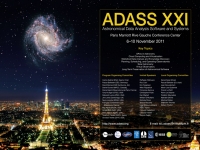Numerical Simulations and Databases in Astronomy and their integration in Grid: FRANEC and BaSTI as a practical example
Massimo Sponza (INAF), Dr. VUERLI Claudio (INAF), Dr. CASSISI Santi (INAF), Dr. PASIAN Fabio (INAF), Dr. PIETRINFERNI Adriano (INAF), Dr. TAFFONI Giuliano (INAF)
Abstract
Stellar evolutionary computations are extremely important to face a wealth of astrophysical problems, but they are also extremely demanding in terms of computing power and data storage. The Bag of Stellar Tracks and Isochrones (BaSTI) is a theoretical astrophysical catalogue that collects fundamental data sets involving stars formation and evolution. To create this database it is necessary to run a large number of stellar evolutionary computations. The Grid seems to be a promising answer for data storage and processing needs of BaSTI. The �gridification� of FRANEC, the stellar evolutionary code used to populate BaSTI, is extremely convenient in terms of data processing speed and data sharing; it can be a valuable instrument to support Astrophysical research. To allow users to run FRANEC simulations we created some specific services on gLite general environment. We designed these Grid tools to be modular and to foster the integration with new software components; in this way subsequent upgrades of the system are eased (this is necessary if we want to allow users to develop new code). The most important step was the creation of the GUI by integration of this services in the P-GRADE Grid portal, enabling users to provide only data requested to run a FRANEC simulation without worrying about the provision of other data structures requested to port the job in Grid.
The most part of Astronomers still perceive the Grid as a tricky technology, hard to approach and use; the learning curve is felt to be too steep to be worthwhile for astrophysical research. As illustrated above, the results achieved through this work contribute to fill in this gap. The integration in P-GRADE hide the complexity of the underlying infrastructures and services, enabling users to access and exploit all provided functionalities through a few mouse clicks; in this way the barriers currently hampering the wide adoption of the Grid to solve astrophysical problems are lowered.
The work carried out so far demonstrated that a Grid environment can be successfully used to run numerical simulations, that can be used to create and update a community service; the BaSTI catalogue and its feeding FRANEC evolutionary code are clear examples of such simulations. The implemented system hides some of the complexity in the use of the Grid; it was expressly designed to be similar to the one used by Astronomers to submit jobs on a workstation. This strategic choice proved to be successful, as end users are not requested to acquire know-how on the Grid technicalities to run their jobs on the Grid Infrastructure.
Poster in PDF format
Paper ID: P145
Poster Instructions

